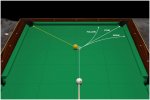Patrick Johnson
Verified Member
- Joined
- Jul 31, 2008
- Messages
- 1,447
Take a look at Mike Page's video (linked in my post above) for a convincing demonstration of that.That 30 degree deflection from 1/4 to 3/4 hit was incomprehensible to me until someone 'splained it. So many shots seem to come up wanting to roll a straight back bank that are on a scratch angle almost no matter where you hit the OB.
pj
chgo

